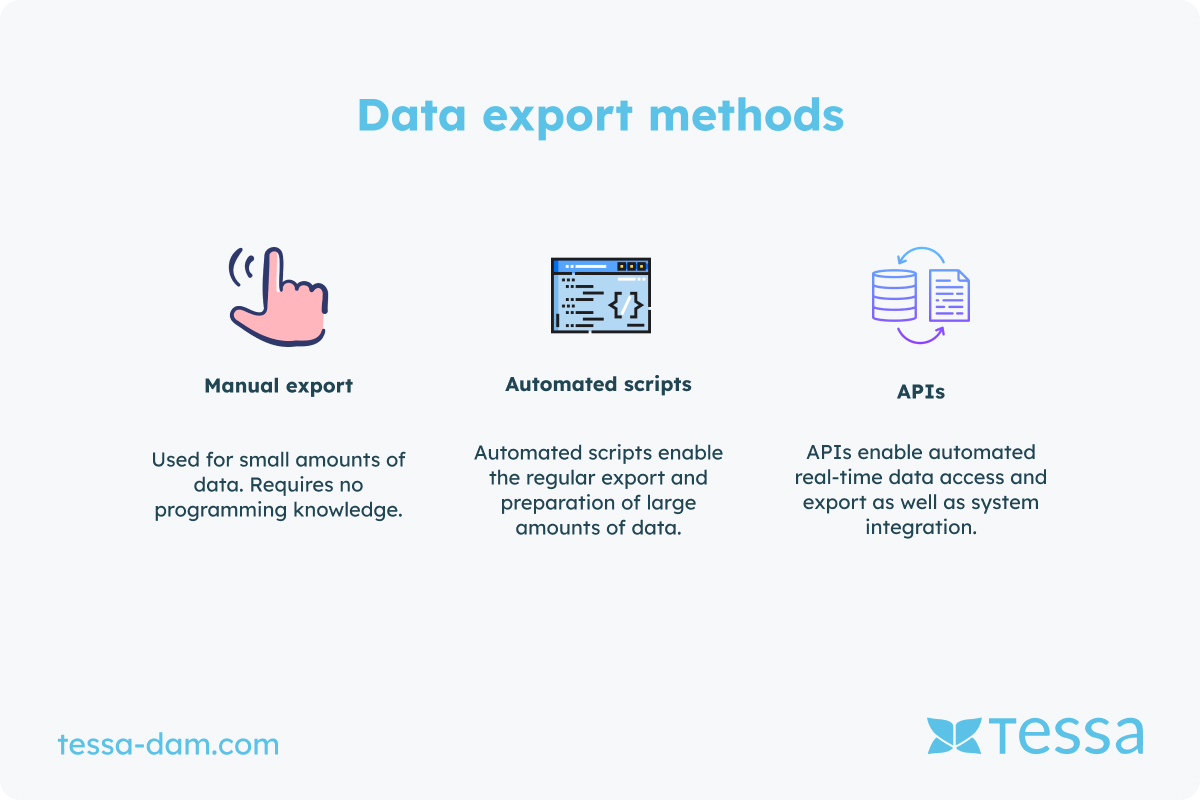Introduction
In today's digital era, handling large volumes of data has become both a central challenge and a significant opportunity for businesses. Data export plays a crucial role by enabling the transfer and use of data between various systems, formats, and applications. Efficient data export allows organizations to extract, analyze, and share information, leading to improved decision-making processes and increased operational efficiency. This text highlights the key aspects of data export and examines the integration of Digital Asset Management (DAM) systems into this process to better understand the benefits and challenges of this topic.
What is Data Export?
Data export refers to the process of extracting data from an internal system or database and transferring it to another system or format. This can be necessary for various reasons, such as data backup, report generation, or integration with other applications. Data export can be performed manually through user interfaces or automated via scripts and APIs (Application Programming Interfaces). Common export formats include CSV (Comma-Separated Values), XML (eXtensible Markup Language), and JSON (JavaScript Object Notation). These formats are widely used and supported by many analysis and processing tools. CSV files are particularly popular for exporting tabular data, while XML and JSON are often used for more complex data structures.
Data export is not limited to simple database tables; it also includes the transfer of more complex datasets and digital assets, such as images, videos, and documents stored in Digital Asset Management (DAM) systems. These data can be exported to various target systems for analysis, reporting, or further processing. More information on the special case of data export and DAM will follow later in the text.
How Does Data Export Work?
Data export can be carried out in various ways, depending on specific requirements and the systems used. Here are the main methods and formats:
Methods
Manual Export: This method is often used when only small amounts of data need to be exported or when data is needed infrequently. Users employ graphical user interfaces (GUIs) of applications or database management systems to export data in formats like CSV, Excel, or XML. This method is straightforward and requires no programming skills but can be time-consuming and error-prone, especially with large volumes of data.
Automated Scripts: For regular export of large datasets or complex data structures, automated scripts are the preferred method. These scripts, written in programming languages such as Python, R, or SQL, can be scheduled and executed to export data regularly. They allow for filtering, transforming, and cleaning data before export, thereby improving data quality.
APIs (Application Programming Interfaces): APIs enable automated and programmatic access to data and its export from a system. Many modern applications and databases offer RESTful APIs or SOAP web services, allowing developers to access and export data in real-time. APIs are particularly useful for integrating data from various systems and creating custom applications.
Formats
ETL Tools (Extract, Transform, Load): ETL tools are specialized software solutions that automate the entire process of data export, transformation, and loading into a target system. These tools offer user-friendly interfaces and powerful features for handling large and complex datasets. Well-known ETL tools include Talend, Informatica, and Microsoft SQL Server Integration Services (SSIS).
Export Formats: The choice of export format depends on the target system's requirements and the nature of the data. CSV (Comma-Separated Values) is a widely used format for tabular data due to its simplicity and universal support. XML (eXtensible Markup Language) and JSON (JavaScript Object Notation) are structural formats suitable for hierarchical and complex data. Other formats include Excel, Parquet, and Avro, each offering specific advantages like better compression or schema support.
Reasons for Data Export
Data exports are necessary in various scenarios crucial for the smooth operation and strategic planning of businesses:
- Integration of New Software: When switching to new software solutions or implementing new systems, data must be exported from old systems and imported into the new system. This ensures all relevant data remains available, and the transition is seamless.
- Data Migration to the Cloud: Many companies migrate their data to cloud-based systems to benefit from scalability, flexibility, and cost efficiency. Exporting data from local systems and importing it into cloud services is a critical step in this process.
- Report Generation and Analysis: For generating reports and conducting analyses, data must be regularly exported and imported into analysis tools. This enables companies to monitor performance metrics, identify trends, and make informed decisions.
- Data Backup and Archiving: Data export is a vital component of backup and archiving strategies. Regular data exports ensure companies protect their data from loss and can restore it when needed.
- Compliance and Legal Requirements: In many industries, companies must export data to meet legal and regulatory requirements. This can include the regular submission of data to regulatory authorities or the creation of audit reports.
- Collaboration and Data Sharing: Data export facilitates data exchange between different departments, business partners, and customers. This promotes collaboration and improves operational efficiency.
Data Exports and Digital Asset Management (DAM)
Integration of DAM Systems
Digital Asset Management (DAM) systems play an increasingly important role in data export, especially when managing and providing digital content. DAM systems allow companies to centrally store, organize, and manage their digital assets, such as images, videos, graphics, and documents. These assets can then be selectively exported for use in various applications and media channels.
Benefits of Using DAM in Data Export
Integrating DAM systems offers several benefits for data export:
- Centralized Management: Central storage and management of digital assets in a DAM system ensure that all assets are current and consistent. This simplifies export and ensures only authorized and quality-checked content is exported.
- Efficient Provisioning: DAM systems enable quick and efficient provisioning of digital assets for various purposes. Through metadata and search functions, users can specifically search for certain assets and select them for export.
- Automation of the Export Process: DAM systems offer features for automating the export process. This includes the ability to automatically convert assets into various formats and distribute them to different destinations or platforms. Automation reduces error-proneness and minimizes the time required for manual interventions.
- Improved Collaboration: DAM systems enhance collaboration between teams and departments by providing a central location for accessing digital assets. This enables different stakeholders to efficiently collaborate and share content, increasing productivity.
- Scalability and Flexibility: With a DAM system, companies can scalably manage and expand their digital assets. This is especially important for companies with growing asset inventories and increasing data export requirements.
Integrating DAM systems into the data export process offers not only organizational benefits but also helps improve the quality and consistency of exported digital content.
Conclusion
An indispensable part
Data exports are an indispensable part of modern data processing and management. Efficient data transfer and utilization allow companies to increase operational efficiency, make informed decisions, and remain competitive. Integrating Digital Asset Management (DAM) systems opens up additional opportunities to optimize data export by simplifying and automating the management and provision of digital content. Companies that understand and apply best practices in data export can improve their data strategies while ensuring the security and quality of their data.





